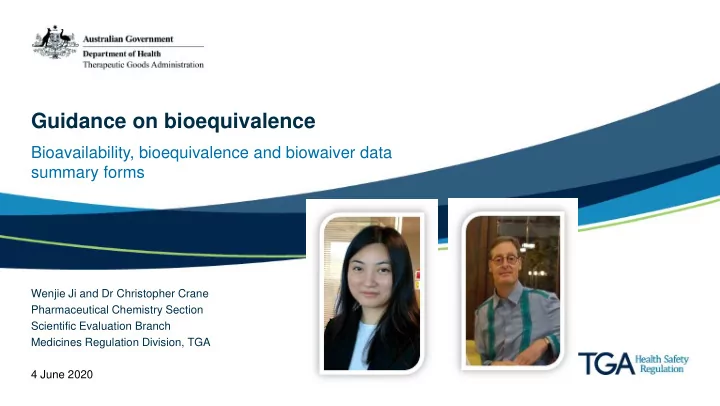

Guidance on bioequivalence Bioavailability, bioequivalence and biowaiver data summary forms Wenjie Ji and Dr Christopher Crane Pharmaceutical Chemistry Section Scientific Evaluation Branch Medicines Regulation Division, TGA 4 June 2020
Today’s objectives • Background • How does it help you • How to complete the new forms • Recent updates • Q&A 1
New data summary forms - Published in December 2019 • Bioequivalence study • Additional strength biowaiver • Biopharmaceutics Classification System (BCS)-based biowaiver The forms are: • Non-mandatory • New prescription generic medicine submissions • Currently, we have received completed templates in submissions 2
Background • Using data summary forms – not new concept e.g. Swissmedic, Health Canada, World Health Organization (WHO) and etc • Effects of using these forms – Support for sponsors with respect to meeting technical requirements – Increased efficiency to the evaluation process 3
Background • February 2019 public consultation: Reforms to the generic medicine market authorisation process – Reducing barriers through international alignment – Increased clarity and transparency of regulatory requirements – Supporting work sharing opportunities – Need for a robust supply of medicines in Australia 4
Background • 23 consultation submissions received from medicine industry, industry bodies, health professionals, consumer groups, international technical working group and a statutory authority • Feedback received: strong support for the reform Specifically for the forms: adopting forms Increase clarity and transparency Increase international alignment Increase opportunity for international collaboration Reduce regulatory burden 5
Design of the forms The new forms were developed based on: • Bioequivalence study information form developed by Australia-Canada- Singapore-Switzerland (ACSS) Consortium – Similar to forms used by Swissmedic, Health Canada, WHO – Most key technical requirements are the same • Biowaiver templates developed by International Pharmaceutical Regulators Programme (IPRP) ≈ – Similar to forms used by WHO – Most key technical requirements are the same 6
Design of the forms • Q&A style format – Better clarify what information to provide – Consistent style – Additional TGA guidance to help complete the forms 7
Greater consistency/reducing burden • Now, accepting completed overseas forms – Bioequivalence study form submitted to Canada Singapore Switzerland – IPRP biowaiver forms submitted to one of our comparable overseas regulator With the condition that: • Your overseas submission has been accepted for evaluation Full details on condition of acceptance is detailed in a guidance prepared for the forms Consequently, you may be using an overseas reference product . 8
Greater consistency/Reducing burden • Existing mandatory requirements – CTD module 1.9.1 - Summary of a Bioavailability or Bioequivalence Study form – CTD module 2.5 – CTD module 2.7 Not required for most new generic prescription medicine submissions • See full details in guidance 9
Difference of new form vs. existing form The new form includes applicant’s section and evaluator’s section Applicant specific sections: Evaluator specific sections: • Data summary • Evaluator comment • Location in the dossier for critical • s31 requests raw data • s31 response assessment • Applicant response to the s31 • Final recommendation on bioequivalence requests 10
Where to find the forms 11
Where to find the forms 12
Guidance to help complete the forms The guidance includes sections on: • When to use the forms • How to include forms for an application • Changes to dossier requirements • How to include overseas forms • How to complete the forms including – additional explanatory notes for some section – example responses Any issues contact PCS inbox: pcsinbox@health.gov.au 13
Recent update to the forms On 1 April, the following forms were updated following external feedback: • Bioequivalence Study Information Form (BSIF): – Removed request under section 2.2 to include information on ‘Recent inspections of the clinical and bioanalytical sites by Regulatory Authorities’ – Guidance updated, where explanatory notes of this part was removed • Additional biowaiver form: – A minor editorial amendment has been made to the assurances in section 3.5.3 14
Questions? 15
Recommend
More recommend